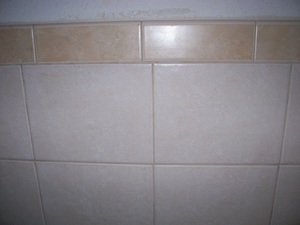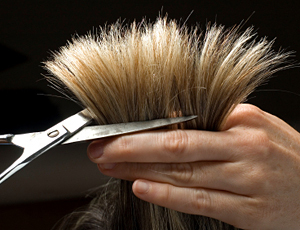There is one home improvement project that has grown in popularity with home owners, and that is the installation of ceramic tile flooring for their kitchen, bath and foyers. You do not have to hire a professional to install ceramic tile in your home, this is one project that looks hard to do, but is fairly easy with the proper tools.
The materials you will need are: Ceramic tile, ceramic tile adhesive, spacers(if tile is not equipped with them), grout, 1/4 inch cement board and grout sealer. The tools you will need to install your ceramic tile flooring are: Pry bar, sponges, cloths, 1/4 inch floor trowel, rubber float, rubber mallet, level, tile cutter, nippers, and a miter saw equipped with a ceramic tile wet/dry blade.
Preparation:
The first step in installing a ceramic floor is the removal of the existing floor application and the base molding. To remove the base molding, gently shimmy the pry bar between the molding and the wall to pop loose. If you are going to reuse the molding, be careful not to damage the molding in the removal process. Once you have removed the base molding and old flooring, you can begin to inspect the sub floor for any boards that are uneven, damaged or cracked. If you notice that a board will give when you step on it, you will need to reinforce it to the joist with nails. Repair any boards that require attention. Remember that it is vital for your floor to be level and sound to ensure proper installation of your ceramic tiles. In some cases, it would be benefifical to install a new subfloor, but not always necessary.
For homes that have a concrete floor, you will need to repair any cracks or dips using concrete repair mortar. Any raised spots on your cement floor can be leveled off smooth by using a sander that is equipped with high grit sandpaper. Once you have swept the entire area, and it is clear from dust and debris, apply a layer of Redgard to the floor using a roller. Redgard is a waterproofing product specially formulated for use on concrete flooring.
The Cement Board Installation
The next step in the ceramic tile installation is to lay out the cement board in a staggering pattern, this will provide strength, and to avoid seams. This step will go much faster if you pre cut the cement board pieces ahead of time to accommodate your floor plan layout. Take your 1/4 inch notched trowel, spread out a even layer of thin set mortar, lay down your first board leaving a 1/8 inch gap from the wall. To set the second board in place, you will lay this board spaced 1/8 inch from the first board, follow this pattern for the remaining first row of cement board. Apply the thin set mortar to the area for the second row, this time the position of the first board will have be laid out with the center to the gap which separates the first two pieces of cement board, this will begin the staggering pattern. Once you have the cement boards in place, you will now fill in the 1/8 inch gaps with mortar. using your trowel. Make sure the gaps are entirely filled in and flush to the surface of the cement board. Allow to dry.
Ceramic Tile Installation:
In this step, you will be locating and marking off the center point of your kitchen floor. To locate the center of your floor, you will be measuring each of the four walls with your measuring tape and marking off with a pencil the center point of each wall. Starting at one wall, take your chalk line and run it across the floor from the pencil mark to the opposite walls pencil mark and snap your chalk line, repeat with the two remaining walls. Where your two snapped chalk lines meet is the center point of your room.
A: Layout
The position of your first tile will depend on the pattern layout you will be using. Typically there are two patterns that you can follow, the first layout will have you setting the first tiles edge butted up against the intersection of the horizontal and vertical lines.The second pattern will have you setting the center of the tile positioned directly over the intersection of the horizontal and vertical chalk line.
In this step of the Tile Installation you will be working in sections. To save time, pre cut any tiles that need to be altered to fit around cupboards, corners, or the edges of your room. These tiles will be inserted after the row of whole tiles are in place. Take your notched trowel, dip it into the pail of adhesive, scoop up a large amount and plop it down onto the floor. Place your trowel notched side down on to the floor by the adhesive, and run it through the adhesive fanning it out in alternating half circles. The result you want to see will be raised beads of adhesive that have transparent spacing in between the rows. Position your first tile according to the pattern you want to follow, and firmly set it into place. If the ceramic tile you are using does not have spacers built in, you will need to use a plastic spacer to ensure straight alignment of tiles, this spacer must be removed before the adhesive sets. Set your second tile into place, if you notice the adhesive is starting to pop up over the edge of the tiles, wipe immediately with solvent and a cloth. Once you have a few rows of tiles laid down, use your rubber mallet and your level to set them evenly into the adhesive.
C. Grouting
In a bucket, mix the tile grout powder with water to the consistency of frosting in a tub. Dip the edge of your rubber float into the mixture and plop it onto the tile near the gaps. Next, position your float over the tile at a 45 degree angle, firmly run it over the tile to force the grout mixture into the gaps. You want to make sure that all the joints are packed fully with the grout, if you notice any gaps in the grouting, repeat the process. Take an object that is smooth and rounded, a toothbrush will work great, and gently run it across the grout seam to shape. Next, take your float and run it across the tiles to remove any excess grout from the surface. Let set for 20 minutes. Using a damp sponge, run it across the tiles to clean away any excess grout. Make sure you rinse sponge often, to ensure the surface will be entirely clean. The cure time for grout is generally one week, it is then that you can apply grout sealer.
When cutting ceramic tiles, using a tile cutter or a ceramic tile wet/dry blade with your miter saw will ensure clean smooth cuts across your marked lines. For corner pieces, or pieces that require several notches, the best tool to use would be the tile nippers and a glass cutter. If your cut tile has any jagged edges, this can be corrected with the use of tile nippers. Tile nippers allows you to nibble off little pieces of tile at a time to correct and fit the tile to its place. If you feel any rough edges on your tile after you have used the nippers, you can use a small round file or sandpaper to smooth off the tile prior to setting them into place.




